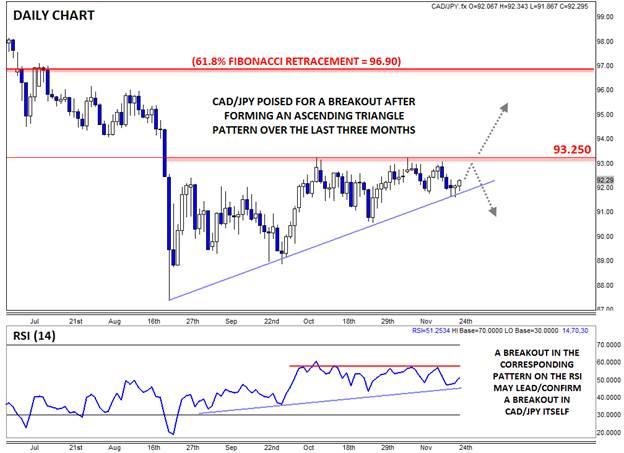![]()
Markets are calming down as US traders filter out for the Thanksgiving holiday, but there is one little-followed pair that could be shaping up for a big move as we head into next week.
CAD/JPY has been consolidating in an increasingly tight range for the last three months, bounded on the top by the 93.25 barrier and on the bottom by rising trend line support (currently around 91.75). This price action has created a clear ascending triangle pattern, which in theory shows growing buying pressure as bulls step in at higher and higher levels following each successive dip. That said, this pattern comes within the context of a longer-term downtrend, so it could easily break lower as well.
It’s worth noting that the RSI indicator has formed an ascending triangle pattern of its own over the last three months. As we often highlight, a breakout in the RSI can serve as a leading or confirming sign of a breakout in price itself. Therefore, astute traders should keep a close eye on this indicator as we move through this week.
While the trading graveyard is littered with analysts who have speculated on geopolitical developments, the simmering conflict between Russia and Turkey could be a catalyst for the pair. After all, the yen tends to strengthen during periods of conflict, and we could also see an impact on oil prices, which are closely correlated with the value of the Canadian dollar.
Regardless of what happens in Turkey, there are less than 150 pips between support and resistance on CAD/JPY, so a breakout is inevitable in the coming days. A confirmed close above the 93.25 level could open the door for a run toward the 50% Fibonacci retracement at 94.25 (not shown) or even the 61.8% retracement around 97.00, whereas a bearish break would likely expose the previous lows at 90.60, 89.00, or even 87.30 in time.
As always, readers are advised to let the price action guide them and be patient for the right opportunity before committing too strongly in either direction.
This research is for informational purposes and should not be construed as personal advice. Trading any financial market involves risk. Trading on leverage involves risk of losses greater than deposits.
Recommended Content
Editors’ Picks
EUR/USD holds below 1.0750 ahead of key US data

EUR/USD trades in a tight range below 1.0750 in the European session on Friday. The US Dollar struggles to gather strength ahead of key PCE Price Index data, the Fed's preferred gauge of inflation, and helps the pair hold its ground.
GBP/USD consolidates above 1.2500, eyes on US PCE data

GBP/USD fluctuates at around 1.2500 in the European session on Friday following the three-day rebound. The PCE inflation data for March will be watched closely by market participants later in the day.
Gold clings to modest daily gains at around $2,350

Gold stays in positive territory at around $2,350 after closing in positive territory on Thursday. The benchmark 10-year US Treasury bond yield edges lower ahead of US PCE Price Index data, allowing XAU/USD to stretch higher.
Bitcoin Weekly Forecast: BTC’s next breakout could propel it to $80,000 Premium

Bitcoin’s recent price consolidation could be nearing its end as technical indicators and on-chain metrics suggest a potential upward breakout. However, this move would not be straightforward and could punish impatient investors.
US core PCE inflation set to signal firm price pressures as markets delay Federal Reserve rate cut bets

The core PCE Price Index, which excludes volatile food and energy prices, is seen as the more influential measure of inflation in terms of Fed positioning. The index is forecast to rise 0.3% on a monthly basis in March, matching February’s increase.
